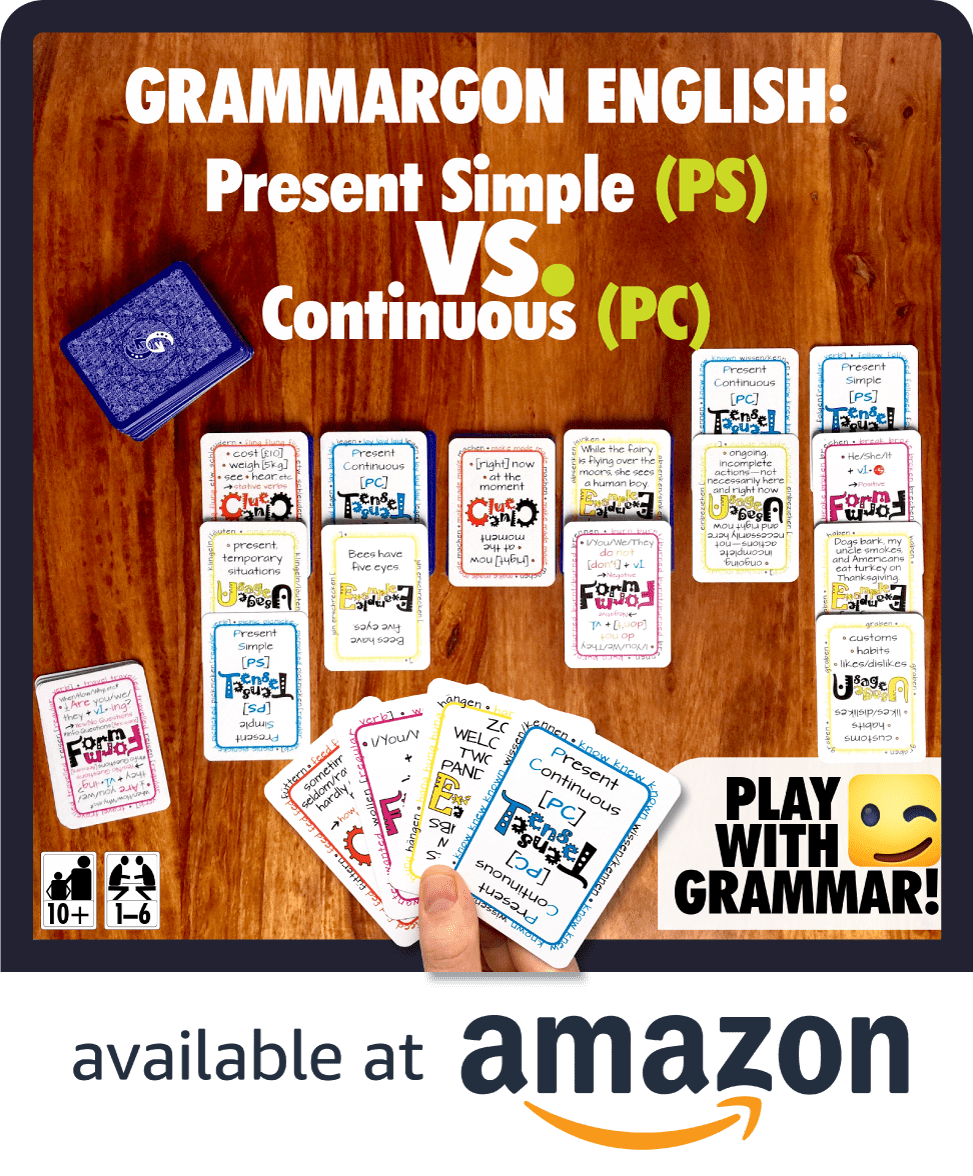The Verb ‘be’ in the Present Tense
In this article, I'm going to show you how the verb 'be' functions alone as a main verb in the present tense.

The Verb ‘be’ in the Present Tense
Introduction
- Function alone as a main verb, or
- Be used as a helping verb in the Present Continuous tense.
The verb 'be' can either:
The good news is that in both cases, all the forms are the same: 'am’, ‘is’, or ‘are’, depending on the subject.
Take note: the verb 'be' can also mean 'to behave/act'. In this case, you can use 'be' (to behave/act) as a main verb in the Present Continuous/Progressive tense in its bare infinitive form, by adding '-ing' ('being'). You can read more about it in my article:
Present Simple VS Present Continuous/Progressive.
 The Positive, Negative and Question Forms of ‘be’ in the Present Tense
The Positive, Negative and Question Forms of ‘be’ in the Present Tense

Positive Form
- I am [’m]
- You/We/They are [’re]
- He/She/It is [’s]
’m, ’re, ’s—are the short forms of the verbs 'am','are', 'is'

Negative Form (‘not’)
- I am not [’m not]
- You/We/They are not [are n’t/’re not]
- He/She/It is not [is n’t/’s not]
’m not; aren't/’re not; isn't/’s not—short forms

Yes/No Questions
Simply swap the positions of the subject and the verb in positive forms to form questions:
- I am ➜ Am I?
- You/We/They are ➜ Are you/we/they?
- He/She/It is ➜ Is he/she/it?

Short Answers to Yes/No Questions
- Yes,
- I am.
- you/we/they are.
- he/she/it is.
Note: you shouldn't use the short form when you answer 'Yes'. The following would be incorrect:“Yes, I’m.” | “Yes, you’re/we’re/they’re.” | “Yes, he’s/she’s/it’s.”
- No,
- I’m not.
- you/we/they aren’t.
- he/she/it isn’t.
Note: ‘not’ is shortened to n’t, but you can’t shorten ‘not’ in 'I’m not' because you have already shortened ‘am’ [‘m] ☺

Information Questions
Information questions are questions that elicit information—not just “Yes”, or “No”.
You can add question words like ‘who’, ‘what (time)’, ‘when’, ‘where’, ‘why’, ‘how’, etc. at the beginning of a Yes/No Question to form an Information Question.
- Yes/No Question:
- “Am I Jessica?” “Yes, I am.”
- Info Question:
- “Who am I?” “I am Jessica.”
- Yes/No Question:
- “Are you/we/they in the garden?” “Yes, you/we/they are.”
- Info Question:
- “Where are you/we/they?” “They are in the garden.”
- Yes/No Question:
- “Is he/she/it here?” Yes, he/she/it is.”
- Info Question:
- “Why is he/she/it here?” “He/She/It is here to pick up the package.”
 USAGE of ‘be’ as a Main Verb In The Present Tense
USAGE of ‘be’ as a Main Verb In The Present Tense
As a main verb in the present tense, ‘be’ is used alone, mostly to describe people, places, or things, without including an action.
Here are sentences which show a variety of USAGES:

USAGE #1: ‘be’ with an adjective
- “I am tired.” (singular, 1st person)
short form ➜ “I'm tired.” - “You are awesome!” (singular and plural, 2nd person)
short form ➜ “You're awesome!” - “He is smart.” (singular, 3rd person)
short form ➜ “He's smart.” - “She is funny.” (singular, 3rd person)
short form ➜ “She's funny.” - “It is hot.” (singular, 3rd person)
short form ➜ “It's hot.” - “We are happy.” (plural, 1st person)
short form ➜ “We're happy.” - “They are cute” (plural, 3rd person)
short form ➜ “They're cute.”

Usage #2: To talk about the occupation or function of someone or something
- “I am a teacher.” (singular, 1st person)
short form ➜ “I'm a teacher.”
“We are teachers.” (plural, 1st person)
short form ➜ “We're teachers.” - “You are a programmer.” (singular, 2nd person)
short form➜“You're a programmer.”
“You are programmers.” (plural, 2nd person)
short form ➜ “You're programmers.” - “He is a dancer.” (singular, 3rd person)
short form ➜ “He's a dancer.”
“They are dancers.” (plural, 3rd person)
short form ➜ “They're dancers.” - “She is a doctor.” (singular 3rd person)
short form ➜ “She's a doctor.”
“They are doctors.” (plural, 3rd person)
short form ➜ “They're doctors.” - “It is a robot.” (singular, 3rd person)
short form ➜ “It's a robot.”
“They are robots.” (plural, 3rd person)
short form ➜ “They're robots.”
Note: in the English language, you can use the plural pronoun 'they' to replace the singular pronouns 'he' or 'she' when a person's gender is unknown.

USAGE #3: to say what someone or something’s nationality is
- “I am German.”
short form ➜ “I'm German.” - “You are French.”
short form ➜ “You're French.” - “He is Spanish.”
short form ➜ “He's Spanish.” - “She is American.”
short form ➜ “She's American.” - “It is Greek.”
short form ➜ “It's Greek.” - “We are South Africans.”
short form ➜ “We're South Africans.” - “They are Japanese.”
short form ➜ “They're Japanese.”
You can also add ‘from’—to say what someone or something’s country of origin is.
- “I am from Germany.”
short form ➜ “I'm from Germany.” - “You are from France.”
short form ➜ “You're from France.” - “He is from Spain.”
short form ➜ “He's from Spain.” - “She is from America.”
short form ➜ “She's from America.” - “It is from Greece.”
short form ➜ “It's from Greece.” - “We are from South Africa.”
short form ➜ “We're from South Africa.” - “They are from Japan.”
short form ➜ “They're from Japan.”
Tip! Always capitalise:

USAGE #4: adding an adverb or preposition to show where something or somebody is situated/positioned
- “I am downstairs.”
short form ➜ “I'm downstairs.” - “You are in the kitchen.”
short form ➜ “You're in the kitchen.” - “He is upstairs.”
short form ➜ “He's upstairs.” - “She is in front of the classroom.”
short form ➜ “She's in front of the classroom.” - “It is under the table.”
short form ➜ “It's under the table.” - “We are on the beach.”
short form ➜ “We're on the beach.” - “They are at the festival.”
short form ➜ “They're at the festival.”

USAGE #5: using ‘is’ to say the time, what day it is, or the date
- “It is 5 o’clock.”
short form ➜ “It's 5 o’clock.” - “It is midnight.”
short form ➜ “It’s midnight.” - “Today is Sunday.”
short form ➜ -- - 12.07: “It is the 12th of July.”
short form ➜ “It's the 12th of July.” - “It is my mother's birthday.”
short form ➜ “It’s my mother's birthday.”

USAGE #6: you can add ‘there’ to say that something exists
- “There is a cinema in the city centre.”
There is (singular)
short form ➜ “There's a cinema in the city centre.” - “There are posters on the wall.”
There are (plural)
short form ➜ --

USAGE #7: you can use ‘be’ (is/are) to say what things cost
- Singular:
- “How much is this T-shirt?”
- “It is $25.”
- Plural:
- “How much are these shoes?”
- “They are $85.”

USAGE #8: along with possessive adjectives, you can use ‘be’ to explain who something belongs to, or the relationship between people
- “I am your teacher.”
short form ➜ “I'm your teacher.” - “You are my students.”
short form ➜ “You're my students.” - “He is my son.”
short form ➜ “He's my son.” - “He is her brother.”
short form ➜ “He's her brother.” - “She is my sister.”
short form ➜ “She's my sister.” - “It is its bone.”
short form ➜ “It's its bone.” - “It is my pen.”
short form ➜ “It's my pen.” - “It is his smartphone.”
short form ➜ “It's his smartphone.” - “This is our cat.”
short form ➜ -- - “We are their neighbours.”
short form ➜ “We're their neighbours.” - “They are their friends.”
short form ➜ “They're their friends.”

Possessive Adjectives
- I ➜ my muffin
- you ➜ your croissant
- he ➜ his cup of coffee
- she ➜ her sandwich
- it ➜ its bone
- we ➜ our homemade pesto
- they ➜ their ice cream
As you can see above, possessive adjectives always take a noun:

Demonstrative Pronouns
Another opportunity to review the basics!
Unlike the possessive adjectives, you don’t need to add a noun to demonstrative pronouns.
Pronoun ➜ possessive adjective ➜ demonstrative pronoun
- I ➜ my ➜ mine
- Possessive adjective:
- “This/That is my notebook.” (singular)
- “These/Those are my notebooks.” (plural)
- Demonstrative pronoun:
- “This notebook is mine.” / “This is mine.” (singular)
- “These notebooks are mine.” / “These are mine.” (plural)
- you ➜ your ➜ yours
- Possessive adjective:
- “This/That is your notebook.” (singular)
- “These/Those are your notebooks.” (plural)
- Demonstrative pronoun:
- “This notebook is yours.” / “This is yours.” (singular)
- “These notebooks are yours.” / “These are yours.” (plural)
- he ➜ his ➜ his
- Possessive adjective:
- “This/That is his notebook.” (singular)
- “These/Those are his notebooks.” (plural)
- Demonstrative pronoun:
- “This notebook is his.” / “This is his.” (singular)
- “These notebooks are his.” / “These are his.” (plural)
- she ➜ her ➜ hers
- Possessive adjective:
- “This/That is her notebook.” (singular)
- “These/Those are her notebooks.” (plural)
- Demonstrative pronoun:
- “This notebook is hers.” / “This is hers.”(singular)
- “These notebooks are hers.” / “These are hers.”(plural)
- it ➜ its ➜ --
- Possessive adjective:
- “This/That is its tail. (singular)
- “These/Those are its ears. (plural)
- we ➜ our ➜ ours
- Possessive adjective:
- “This/That is our notebook.” (singular)
- “These/Those are our notebooks.” (plural)
- Demonstrative pronoun:
- “This notebook is ours.” / “This is ours.” (singular)
- “These notebooks are ours.” / “These are ours.” (plural)
- they ➜ their ➜ theirs
- Possessive adjective:
- “This/That is their notebook.” (singular)
- “These/Those are their notebooks.” (plural)
- Demonstrative pronoun:
- “This notebook is theirs.” / “This is theirs.” (singular)
- “These notebooks are theirs.” / “These are theirs.” (plural)
Tip: always capitalise ‘I’ even when it's not at the beginning of the sentence!
“I am making a sandwich because I am hungry.”
('I' is always capitalised regardless of its position in the sentence.)
“He is making a sandwich because he is hungry.”
(The first 'H' is only capitalised because it's at the beginning of the sentence, the second 'h' isn't!)

